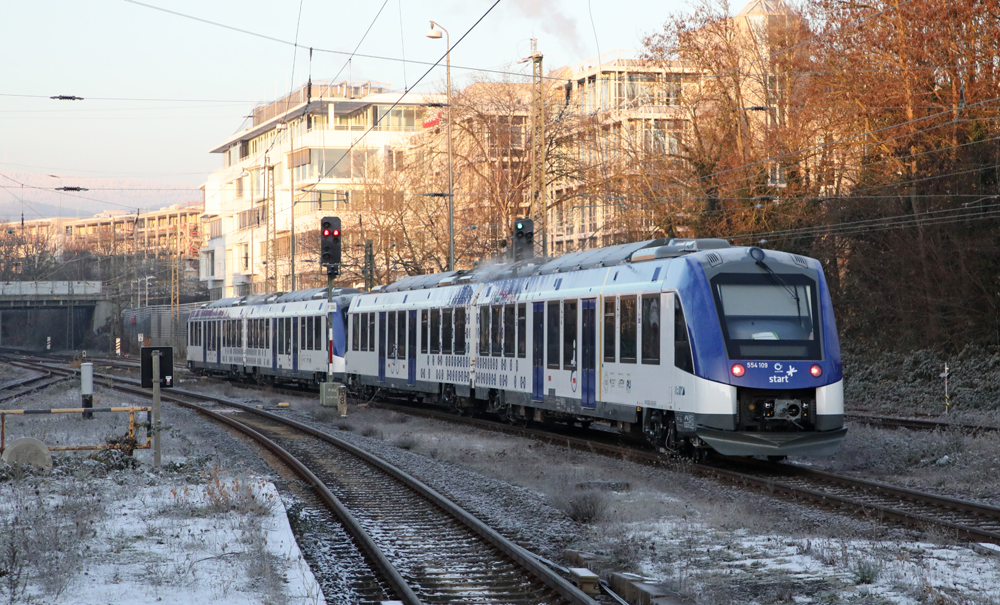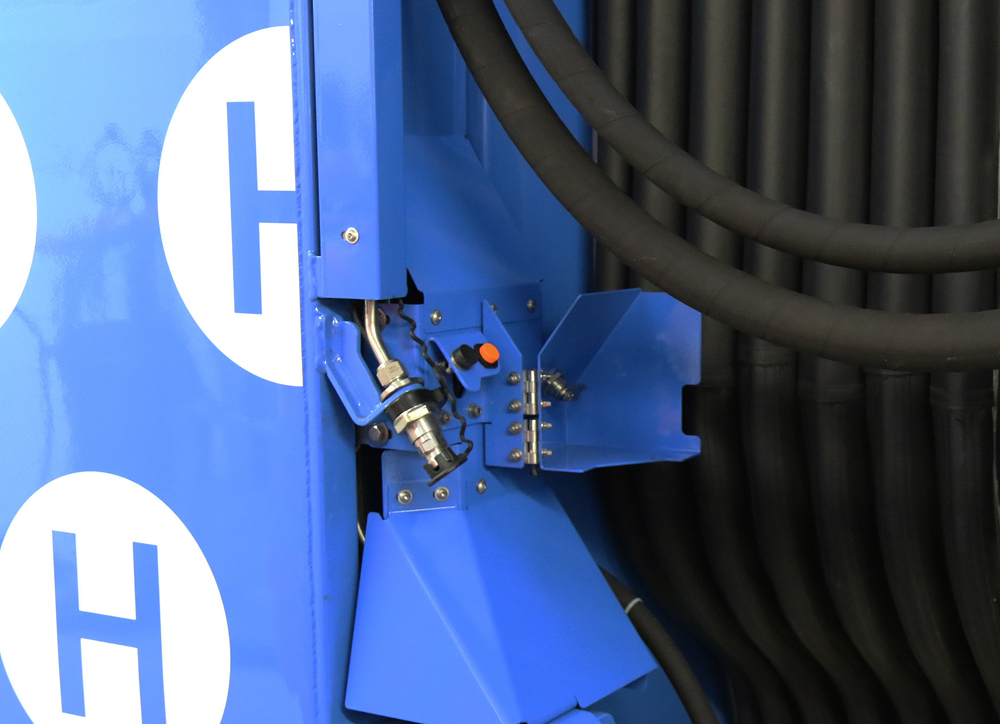
The first winter intended to see regular use of hydrogen-powered passenger trains in Germany has not gone smoothly, with service disrupted by both equipment delivery and operational issues.
The trains entered regular service in mid-2022 [see “World’s first hydrogen trains enter regular passenger service,” Trains News Wire, July 26, 2022]. Prototype trains had been running for several years — one of which is now set for a demonstration in Canada this summer [see “Alstom’s hydrogen passenger train to debut in Quebec,” News Wire, Feb. 3, 2023].
A fleet of 27 hydrogen-powered trains were due to enter service in Frankfurt am Main in central Germany in December 2022, but manufacturer Alstom was unable to deliver more than six of the trains on time, citing supply-chain problems because of the COVID-19 pandemic and war in Ukraine. This meant older diesel multiple-unit trainsets were pressed into operation and many services were cancelled for several weeks.
Worse still, the few hydrogen trains delivered didn’t work well in mid-December temperatures of minus-10 Celsius (14 Fahrenheit), not unusually cold for German in mid-winter. Only two of the six trains were actually working on some days.
The exact operating problems have not been revealed, but the German rail train press reports that putting hydrogen fuel into the trains at low temperatures was a key problem. For the fleet near Frankfurt, operating under rules requiring its hydrogen fuel tanks to be kept at least one-third full at all times, this was made more difficult because the fueling station is inside a chemical works. Having to return there regularly to top up fuel was taking time and engineers that the operating company hadn’t planned for.

The hydrogen trains in use or trial in Europe use filling points mounted on the car body to take in hydrogen, delivered under pressure from specially designed ground fuel stations or from tanker trucks. The fuelling point itself is a steel nozzle that, when not in use, is protected by a moveable cover. Hydrogen itself has a very low freezing point of minus-259.14 Celsius (minus-434 F), so even the coldest outside temperatures will be well above this. It is, however, possible that ice built up around the trains’ fueling points.
On the original hydrogen train routes in the north of Germany, the number of trains in use also fell to around zero on some cold days. The reason wasn’t clear, with manufacturer Alstom telling local media this was due to staff training and regular maintenance, neither of which ordinarily explains why an entire train fleet is out of service. Fortunately, some of the DMU fleet the hydrogen trains were supposed to replace had been retained, and this was used instead.
Whether hydrogen trains can be better adapted for winter operation remains to be seen and train manufacturers, in particular Alstom, need to be more transparent about winter-related problems. German observers have already made the comparison with hydrogen-powered buses, bought for the city of Wiesbaden, also near Frankfurt, which are to be replaced with new diesel ones, after only a year. The local bus company is citing cost and fueling problems with the hydrogen vehicles.
A U.S. study looking at hydrogen-powered buses revealed battery-powered buses lost more range (a 37.8% decrease in distance between recharging stops) than those which are hydrogen-powered (a 23.1% decrease) when temperatures fell from 50-60 degrees to 22-32 degrees, so a drop in performance in terms of range might be expected. The same logic applies for hydrogen-powered trains (although possibly with different actual numbers); however the key takeout is that the trains themselves should remain in use, even if they have to be refueled more often.














Mr. Kenney – you are suffering from rectal-cranial inversion, as your irrational reaction to my comment attests. R&D has always been an important part of any endeavor that can benefit from innovative thinking and technological advancements. The SD40-2 was an outgrowth of EMD’s groundbreaking 567-series prime movers, generators, electronics, and traction motors, just as the Saturn V was an outgrowth of the V-2. The Apollo program required the development of whole new technologies to solve the problems NASA faced in getting a machine with over 1 million working parts, and that weighed 6 million pounds at liftoff, off the ground without exploding with the force of a miniature atomic bomb, and flying in the direction it needed to go to reach a precise point 60 miles above a speeding target that was on the average 240-some-odd-thousand of miles away. The Gemini and Apollo programs were pioneers in the development, testing, and successful use of hydrogen fuel cell technology. We would never have been able to go to the moon without fuel cells.
Now locomotive designers want to adapt that technology for use in powering trains. Great! Have at it!! But make sure
1. they are competitive with diesel and electric in terms of efficiency and cost-effectiveness, and
2. that the motors will function in real-world operating conditions BEFORE you release them for general service.
It’s not a good thing when corporate types do stupid things that have traditionally been the hallmark of government bureaucrats. Unfortunately, the line demarking the two entities has been slowly dissolving in recent years.
To the best of my knowledge, the hydrogen fuel cell trains are a variant on an existing line of Alstom multiple unit trains. If I recall correctly, the iLint can be delivered as conventional electric trains or with diesel engines. The fuel cell power is the new part.
I do not see any fundamental reason why fuel cell technology cannot be used for powering trains in cold climates. The trouble reported with the trains sounds like a design and implementation issue. These problems will be resolved. If you are old enough you may remember when automobiles in cold climates had trouble starting unless the vehicle had a block heater to keep them warm. Technology improved so modern automobiles start in cold conditions without much difficulty.
The train manufacturer, hydrogen supplier and train operator have a problem to solve with the fueling process. Fueling at a chemical plant rather than a fueling point on railroad property sounds like they rushed the equipment introduction. Disposing of the older generation DMUs before the new trains are proven in service seems like a management error particularly when the manufacturer has problems with deliveries.
I expect the problems with hydrogen fuel cell power will be solved and the trains will be able to do the job. CP has built hydrogen fuel cell powered locomotives and is operating them in Alberta between Calgary and Edmonton. Alberta can get very cold so CP should be able to offer information about their experience with hydrogen locomotives in very cold weather.
“Hydrogen Will Not Save Us. Here’s Why.”
https://www.youtube.com/watch?v=Zklo4Z1SqkE&ab_channel=SabineHossenfelder
None of the green options are ready to support normal first-world life.
It’s a start and they’ll figure it out then export it to other countries, it’s still the future.
What a shock – more supposedly “green” technology that doesn’t work as advertised, and is less efficient that the tried-and-true when it does manage to work. One has to wonder why these issues seem to have surprised everyone involved after they entered regular service. Were the units never tested in cold weather? I highly doubt that would be possible in northern climes such as Germany. So those responsible for accepting and approving the hydrogen locomotives must have been aware of these issues and released the units onto service anyway, leaving passengers suffering on cold, windswept platforms waiting for trains that never came. They’re just the latest victims to be sacrificed on the Altar of Climate Change.
Nothing will ever replace the coal-fired steam locomotive. And no one should ever try anything new. Ever…………………
Hydrogen Trains — locomotives and MUs — have big battery packs to supply peak power and store power from regeneration braking, so H2 trains would see reduced range in cold weather from issues with their batteries. As for the fuel cells, could be too, lots of tech doesn’t like the cold.
Most hydrogen is produced from natural gas by splitting off H2 and creating CO2 as waste. Germany and Europe have a bit of a problem getting natural gas; perhaps that is the root of the problem?
Hydrogen powered trains are performative greenwashing. How about stringing catenary instead and use proven technology?
Europe now gets its NG from Norway via pipeline.
They ought to find out how it flows in a pipeline and copy that technology. Even if the temperature raised to a higher degree that was still less than zero it could still be pumped into chillers before utilized. Power plants have been using H2 for cooling high heat bearings for years and that is what they do…
It doesn’t have to be super cooled to burn or transport, Somebody has missed a step, I imagine.